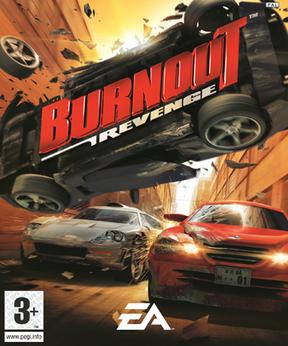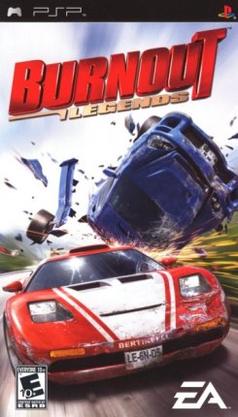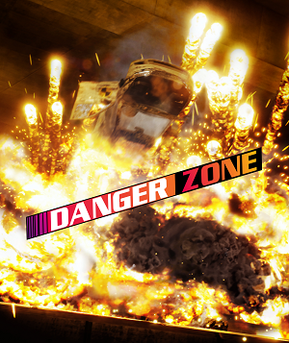Need for Speed (NFS) is a racing game franchise published by Electronic Arts and currently developed by Criterion Games, the developers of Burnout. The series generally centers around illegal street racing and tasks players to complete various types of races while evading the local law enforcement in police pursuits. The series is one of EA's oldest franchises not published under their EA Sports brand. The series released its first title, The Need for Speed, in 1994. The most recent game, Need for Speed Unbound, was released on December 2, 2022. Additionally, a free-to-play mobile installment released in 2015, Need for Speed: No Limits, is actively developed by Firemonkeys Studios, the developers of Real Racing 3.

Burnout is a 2001 racing video game developed by Criterion Games and published by Acclaim Entertainment for the PlayStation 2, GameCube and Xbox.

Burnout 3: Takedown is a 2004 racing video game developed by Criterion Games and published by Electronic Arts. It is the third instalment in the Burnout series, which is characterised by fast-paced arcade racing. A staple of the series is the use of boost, earned through risky driving, to rapidly increase a car's speed. The central mechanic introduced in Burnout 3 is Takedowns, which allow players to slam their opponents until they crash. Takedowns work in conjunction with the boost system by filling up and extending the boost meter. Aside from standard circuit races, the game features modes focused on performing Takedowns on rival vehicles and causing monetary damage at a junction occupied with traffic. Each game variant is featured in a single-player campaign mode called World Tour, which serves as the primary method for unlocking new and faster cars. The game supports both online and split-screen multiplayer.

Burnout 2: Point of Impact is a 2002 racing video game developed by Criterion Games and published by Acclaim Entertainment for PlayStation 2, GameCube and Xbox. It is the sequel to the 2001 video game Burnout and the second title in the Burnout series. It was the last Burnout game to be released on the GameCube and the series would not see a release on a Nintendo platform until the release of Burnout Legends in 2005. The game also marked Acclaim's last entry in the Burnout series, as Acclaim would go bankrupt in 2004; the rest of the series would be published by Electronic Arts.
Criterion Games is a British video game developer based in Guildford. Founded in January 1996 as a division of Criterion Software, it was owned by Canon Inc. until Criterion Software was sold to Electronic Arts in October 2004. Many of Criterion Games' titles were built on the RenderWare engine, which Criterion Software developed. Notable games developed by Criterion Games include racing video games in the Burnout and Need for Speed series. As of April 2017, Criterion Games employ approximately 90 people.

Burnout Revenge is a 2005 racing video game developed by Criterion Games and published by Electronic Arts for PlayStation 2, Xbox and Xbox 360.

Burnout Legends is a racing video game developed by Criterion Games and published by Electronic Arts for PlayStation Portable. The game features many of the tracks and gameplay modes from the first three Burnout titles but repackaged for the handheld format. Many of the gameplay modes are similar to Burnout 3: Takedown using a mixture of old and new tracks. The Nintendo DS port was developed by Visual Impact.

Need for Speed: Carbon is a 2006 racing video game and the tenth installment in the Need for Speed series. Developed by EA Black Box, Rovio Mobile and published by Electronic Arts, it was released on October 31, 2006, for the PlayStation 2, PlayStation 3, Xbox, Xbox 360, GameCube, Windows, and Mac OS X, and on November 19, 2006 as a launch title for the Wii and in 2008 for arcade cabinets. The game sees players conducting illegal street races within the fictional city of Palmont City, with the game's main story taking place after the events of Need for Speed: Most Wanted and focusing on the player's character taking control of the city from various street-racing gangs. While the gameplay is similar to its predecessor, Carbon introduced a number of new features, including crews and racing wingmen, Touge-styled racing events, and greater customization options.

Burnout Dominator is a 2007 racing video game developed by EA UK and published by Electronic Arts for PlayStation 2 and PlayStation Portable. It retains the core gameplay of the series, as players race at top speeds through dozens of World Tour events testing "reckless skill-based" driving techniques.

Burnout Paradise is a 2008 racing video game developed by Criterion Games and published by Electronic Arts for PlayStation 3, Xbox 360 and Microsoft Windows. It was also released on the PlayStation Store and via Xbox Live Marketplace's Games on Demand. It was later added to the libraries of Greatest Hits and Platinum Hits titles and was made backward compatible with the Xbox One in November 2016. It is the first game in the Burnout series to be released on Microsoft Windows.

Need for Speed: Hot Pursuit is a 2010 racing video game developed by Criterion Games and published by Electronic Arts for PlayStation 3, Xbox 360, Wii, Microsoft Windows, iOS, Android, webOS, and Windows Phone. The Wii version was developed by Exient Entertainment. Hot Pursuit is the sixteenth Need for Speed title and was released in November 2010, with digital distribution versions released within December 2010. This version is a reboot of Need for Speed III: Hot Pursuit (1998). A remastered version, titled Need for Speed: Hot Pursuit Remastered, was released on November 6, 2020, for Microsoft Windows, PlayStation 4 and Xbox One, and on November 13, 2020, for Nintendo Switch.

Burnout Crash! is a downloadable action racing video game in the Burnout series. It is developed by Criterion Games and published by Electronic Arts for PlayStation 3, Xbox 360, iOS via PlayStation Network, Xbox Live Arcade, and iTunes App Store.

Need for Speed: Most Wanted is a 2012 racing game developed by Criterion Games and published by Electronic Arts. Most Wanted is the nineteenth title in the Need for Speed series and was released worldwide for Microsoft Windows, PlayStation 3, Xbox 360, PlayStation Vita, iOS and Android, beginning in North America in 2012, with a Wii U version following in 2013 under the title Need for Speed: Most Wanted U. The game picked up on the Most Wanted intellectual property, as opposed to the Hot Pursuit reboot that Criterion Games developed previously.

Need for Speed: Most Wanted is a 2005 racing video game, and the ninth installment in the Need for Speed series. Developed by EA Canada and EA Black Box and published by Electronic Arts, it was released in November 2005 for PlayStation 2, Xbox, GameCube, Nintendo DS, Microsoft Windows, Game Boy Advance and Xbox 360. An additional version, Need for Speed: Most Wanted 5-1-0, was released in the same year for PlayStation Portable. The game focuses on street racing-oriented gameplay involving a selection of events and racing circuits found within the fictional city of Rockport, with the game's main story involving players taking on the role of a street racer who must compete against 15 of the city's most elite street racers to become the most wanted racer of the group, in the process seeking revenge against one of the groups who took their car and developing a feud with the city's police department.

Need for Speed Rivals is a 2013 racing video game developed in a collaboration between Ghost Games and Criterion Games, and published by Electronic Arts. It is the twentieth installment in the Need for Speed series and the debut title for Ghost Games, who would be established as the primary developer of the series for all subsequent non-mobile installments up until 2020. Rivals was well received by critics at E3 2013 and was awarded with "Best Racing Game" from Game Critics Awards. It also received mostly positive reviews upon release. It was followed in 2015 by the mobile game Need for Speed: No Limits and the unsubtitled reboot of this franchise.

Need for Speed is a 2015 online racing video game developed by Ghost Games and published by Electronic Arts. The game was released for PlayStation 4 and Xbox One in November 2015, while a Windows version released in March 2016. It is the twenty-second installment in the Need for Speed series, and is a reboot of the franchise.

Dangerous Golf is a miniature golf game developed by Three Fields Entertainment, a studio formed by former Criterion Games founders and developers Fiona Sperry and Alex Ward. The game, as stated by the studio, is a mix of Burnout, Black, and NBA Jam, in which players attempt to cause the most destruction by playing miniature golf within a confined space, such as a china shop or a kitchen. The game was released for Microsoft Windows, PlayStation 4, and Xbox One in June 2016.

Danger Zone is a video game developed by Three Fields Entertainment. The game involves driving vehicles at high speeds into various traffic situations to cause as much damage as possible. It is directly inspired by the Crash mode in the various Burnout games developed by Criterion Games, which the founders of Three Fields had been a part of prior to founding their own studio. It was released in May 2017 on Microsoft Windows and PlayStation 4 systems, and in October 2017 for Xbox One.
Three Fields Entertainment Limited is a British video game development studio. It was founded in February 2014 by Alex Ward and Fiona Sperry, who had previously worked at Criterion Games, along with developer Paul Ross who had worked with them under Criterion Games.

Dangerous Driving is a racing video game developed by Three Fields Entertainment, released on 9 April 2019 for Microsoft Windows, PlayStation 4, and Xbox One.
















